Do you remember the last off-topic post? Maybe not everyone liked it, but because my knowledge about elegant dresses expanded, I decided to write the second part. It will contain similiar information, but some aspects will be revised or added. More photos will appear, too. For everyone interested in this subject, I recommend Wikipedia and Black Tie Guide, a site mainly about eveningwear, and for asking more specific questions Andy Gilchrist's forum.
At the end I say that I won't write about basic rules about wearing such garments (last jacket button unfastened, the proper trousers lenght etc.). Elementary, gentlemen. :)
Let's get to the point:
elegant dresses can be divided in two ways: by the time of wearing (daywear - until 6 P.M., eveningwear - after 6 P.M. or dark) or by the degree of formality. I'll divide it in this first way, but inside of these categories they will be ordered by degree of formality (descending). At the beginning I'll also post the ranking.
All elegant dresses fall into four categories: Formal, Semi-formal, Informal and Smart Casual. I hope that in the table it will be more readable.
| Dresses | daywear | eveningwear |
| formal | morning dress frock coat (a bit more formal than morning dress, but rarely used) morning suit (the least formal) | white tie |
| semi-formal | stroller (nowadays rarely used) | black tie (also known as tuxedo also known as dinner jacket) mess jacket, in thirties civil garment, now only military evening dress |
| informal | lounge suit | like in daywear |
| smart casual | navy blazer | like in daywear |
There is also dividing elegant dresses into "full dress", "half dress" and "undress", which is however archaic and doesn't reflect contemporary notion of formality very well. "Full dress" is frock coat or white tie, "half dress" is morning dress, and "undress" is black tie, lounge suit and all casual wear.
Let's start from daywear:
1. Morning dress:




Morning dress is the most formal daytime men dress. In Poland, some people (especially on wedding fora and guides for bridegrooms) call it "cut" (as if an abbreviation for "cutaway", morning coat), but this name is very inappropriate, moreover nowhere and never used.
It's composed of following parts:
- a morning coat, the characteristic coat. It's a frock coat (a coat reaching knees) with a triangular part of cloth cut away in the front, like it can be seen on illustrations. Morning coat should:
- be black or Oxford gray (the early more formal)
- be made of wool
- have one vent
- have in the front one (in some obsolete models two) button (it can be replaced by a chain link, two buttons connected by a chain, placed into two holes in coat; it can be seen on the third illustration) and two decorative buttons at the back (above the vent)
- have peaked lapels, formerly notched lapels were also correct
- have one welt breast pocket
- have four buttons on each sleeve
- have a waist seam, which will give it the proper shape.
An optional feature is decorative silk braiding around edges of the coat and lapels, like it can be seen on the third illustration (it diminishes formality of the coat).
- striped trousers, or trousers in special, black and white pattern, which from a distance looks like grey in black stripes:

Other permissible patterns are checks (on left) and chalk stripes (on right):

Irrespective of pattern, they should:
- be made of wool
- not have cuffs
- have one pleat on each leg
- be made to be worn with braces, ie have special buttons for attaching them and preferably fishtail back:

- a waistcoat. When the coat it buttoned, it shouldn't protrude too much from above or from below it. Theoretically it can be in any bright, pastel colour, but the most appropriate are dove gray and buff (creamy yellow). The most formal colour is black. Besides these, the best are lavender, biscuit, off-white and white. Permissible materials include wool, cashmere, silk, cotton and linen. The waistcoat can be single- or double-breasted, it also should have lapels. It can be seen well in this photo (this colour is exactly buff):

It should be remembered that the last button of single-breasted waistcoat should be unfastened.
An optional addition is a slipped waistcoat. In fact it isn't a waistcoat, but a piece of cloth sewn onto the real waistcoat, which imitates the second waistcoat worn underneath. It originates from the custom of wearing two waistcoats, practiced in Regency period. This effect can be seen on the fragment of photo from Prince Charles' wedding, where he was wearing a morning dress:
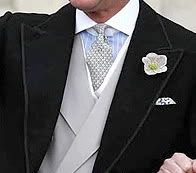
- a shirt. It should be white or other bright colour (subtle stripes are admissible) and should be fastened with buttons, it also shouldn't have stiff bosoms, characteristic for eveningwear. Two kinds of morning dress shirts are distinguished:
- the first kind:
- has got a detachable, high, white wing collar
- should be white
- can be worn only with black coat
- should have got single cuffs closed with cufflinks
- by some people is considered inappropriate for weddings.
The second kind (can be seen on three last pictures):
- has got a detachable, stiff, white turndown collar
- should have got double cuffs closed with cufflinks.
Standing collars are appropriate, but rather obsolete.
Detachable collars are attached by two studs - the longer one in the front, the shorter one at the back:

- neckwear. The first kind of shirt is worn with ascot tie, shown in the first photo.

The second kind of shirt is worn with regular four-in-hand tie.
For standing collars, both kinds of neckwear are appropriate.
Black, silver and gray and with subtle pattern or stripes are obligatory for bridegrooms:

For other occasions, other colours and patterns are permissible. It should be remembered that if the waistcoat is in some other colour than gray, buff and black, the necktie should notwithstanding be more formal.
A bow tie is usually considered inappropriate for morning dress, but it's a correct, but old-fashioned option:
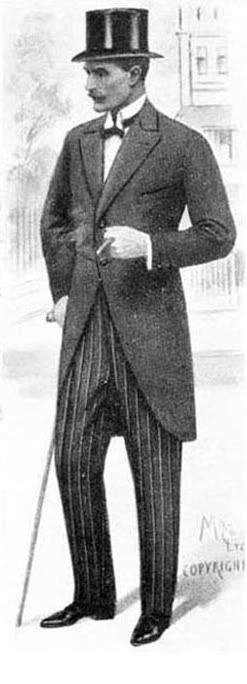

These are basic rules, but four-in-hands are also suitable for wing collars and ascot ties with turndown collars, moreover it doesn't look bad. :)
- footwear. It should be leather, laced, well-polished black shoes, so-called "oxfords", or closed-laced shoes. It looks like that:
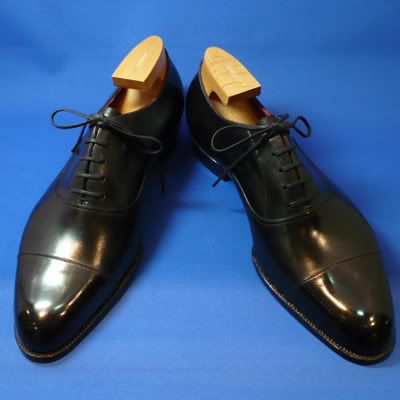
Shoes can also have broguing:

Boots with cloth uppers are also traditional, both lace-ups:

...and button boots:

They shouldn't be made of patent leather in any case.
- socks. Maybe it sounds funny, but not every socks are appropriate for formal dress. :) They should be black or dark gray, made of silk or cashmere. They also should be over-the-calf lenght.
Accesories:
- a cane - the best is black with white, golden or silver handle. If the weather is uncertain, better is to take a black or dark gray umbrella with wooden handle.
- gloves - lemon chamois for black coat (the real chamois leather is nowadays often replaced with leather of sheep, deer or goat), gray suede for gray one. They shouldn't be black in any case.
- a hat - more formal is black, non-collapsible, silk top hat:

Gray felt top hat with black band, like on the photo, is slightly less traditional and elegant:
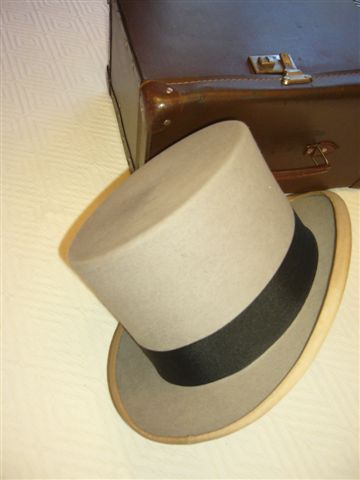
Presently, the silk plush used for production of silk top hats is no more manufactured, so the only way to get a hat made of such a material is buying it used, but they are expensive. Wool or fur felt is used as a replacement.
- an overcoat - it should be black, dark gray or navy blue Chesterfield. It's a overcoat with black, velvet collar and peaked lapels. It can be single- or double-breasted:

In the first case buttons should be covered (fly front). Both overcoats in the picture are Chesterfiels, but the single-breasted one in the background is not quite traditional because it hasn't got a velvet collar.
- a handkerchief - it should be white, made of lawn of linen.
- a boutonniere - it's a flower placed in a hole in the left lapel of coat, which is also called boutonniere. The most appropriate for morning dress are white carnation or rose (only single flower! - bunches and greenery of any kind as well as flowers pinned into the lapel aren't welcome for any garment).
- a watch - the most appropriate for formal dress is a pocket watch with watch chain, which is placed into the pocket of the waistcoat.
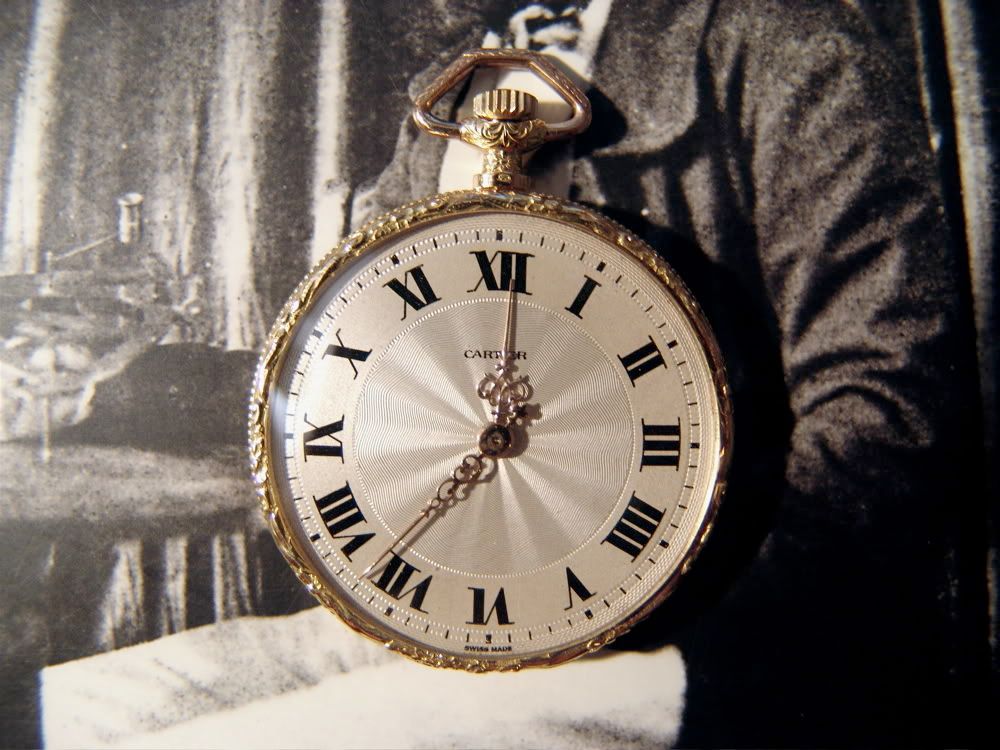
There are also pocket watches with a lid, which protects the glass from scratches and dirt:
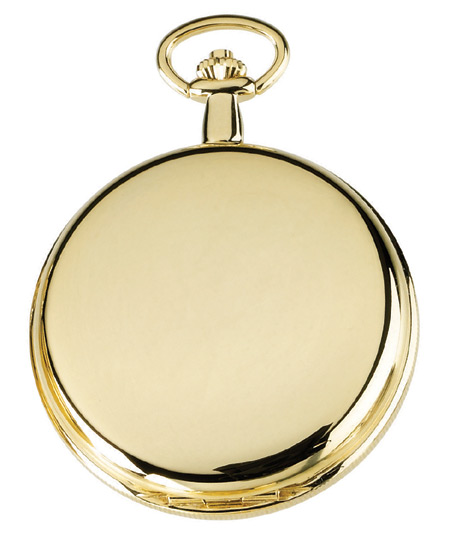
There are two kinds of watch chains - single- and double-ended. In single-ended on the one end there is a T-shaped bar, which is placed into a buttonhole of the waistcoat, and on the second end the watch is attached. In double-ended one the bar is in the middle of the chain, and a fob or a pocket knife can be attached to the second end. The first type is used mainly to the double-breasted waistcoats, the second type is used for single-breasted ones.
If we don't have a pocket watch, we can wear regular wristwatch. It certainly can't be sporting. Something elegant, with black, thin band and the colour matching the colour of cufflinks should be chosen:
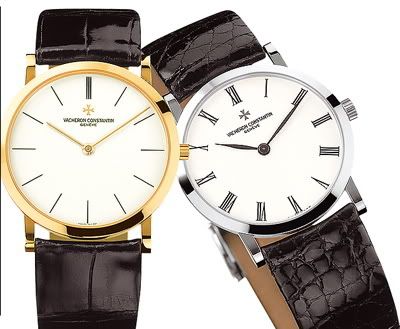
- spats - white or gray. It looks like that:

Nowadays they are rarely used. That's how a morning dress with spats looks alike:

- braces - they are used not only because they are traditional, but also more comfortable than belts, and trousers fit better with them. Only button-on braces are appropriate.
That's all about morning dress.
2. Frock coat:


Frock coat is a formal daytime men dress, today considered as historical. An characteristic - and obligatory - element of it is a large amount of waist suppression obtained by a waist seam (as in morning dress) - without it a frock coat is just a weird overcoat. Two types of frock coats are distinguished - formal (the first illustration) and informal (the second illustration). Here we will talk about the first option, not historical, but that, which is appropriate today.
It's composed of:
- a frock coat, or a coat reaching knees. It should:
- be dark-coloured, usually black, charcoal or midnight blue (very dark navy blue, almost indistinguishable from black - more about it at white and black tie)
- be made of wool
- have peaked lapels, lined with satin, but with self-faced edges, as in the pictures, a special kind of silk called grosgrain is also appropriate:

- be double-breasted - it's a more formal and traditional option, single-breasted frock coats are appropriate for informal occasions
- buttons shouldn't reach the waistline
- have one vent
- have two decorative buttons at the back, above the vent (as in morning dress)
- not have any outer pockets
- have sleeve cuffs with two buttons on each
- all buttons should be lined with the same kind of silk as on lapels.
- striped trousers - see morning dress.
- a waistcoat. The most popular were double-breasted, they should have lapels. It's colour and material that it's made of is determined by occasion and season. Usually for formal occasions, a woolen waistcoat matching the coat or simply black is worn. For festive occasions lighter-coloured waistcoats, like bright gray were acceptable. In summer, white and buff waistcoats were worn. In early Victorian period, colorful, silk, fancy waistcoats were popular. An optional addition is a slipped waistcoat, see morning dress.
- a shirt. I don't know much about it, but I think the shirt should be made of the same material as the shirt for morning dress. However, it can be only white and it must have detachable standing collar. The cuffs are single, fastened with cufflinks.
- neckwear. The most appropriate is ascot tie, as for morning dress (the first type of shirt). Later, regular four-in-hand neckties were worn. A bow tie is an appropriate, but old-fashioned accesory - it was worn mainly in Victorian period.
- footwear - originally patent leather shoes were worn, but now they are reserved for eveningwear. Today black leather oxfords are appropriate for frock coat - see morning dress.
- socks - see morning dress.
Accesories:
- a cane - at one's own fancy, an umbrella is also correct.
- gloves - light gray, made of suede, chamois or kid.
- a hat - black, silk top hat.
- an overcoat - this is a special overfrock - an overcoat sewed exactly the same as the frock coat, but a bit longer, it hasn't got silk-faced lapels, and collar is often velvet:
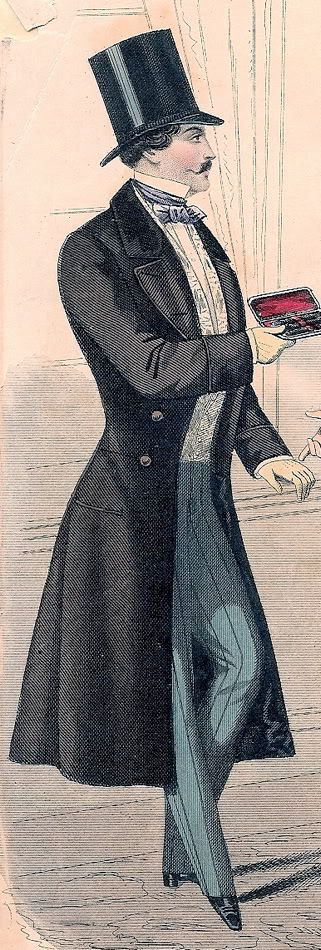
- a boutonniere - see morning dress.
- a watch - see morning dress.
- braces - see morning dress.
Upon the large amount of references "see morning dress" we can see that morning dress and frock coat have a lot in common. No wonder - the first one originates from the second one after all.
3. Morning suit:
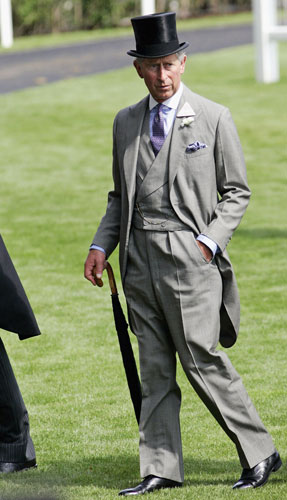
Morning suit is a kind of morning dress that consists of all matching, dove gray pieces. There's nothing much to write, so I place everything in one paragraph. All parts of the dress not only must be the same colour, but they also must be made of the same material, namely wool. Theoretically, ascots and wing collars aren't suitable for this dress due to lack of the black coat - however it's acceptable and quite elegant (in this photo actually wing collar and four-in-hand necktie - quite obsolete combination):

This suit is used instead of the regular morning dress on less formal situations, especially in summer. It's the matter of taste, but I think that a felt gray top hat fits better to this garment.
A black version of this dress is worn on funerals and is called mourning suit. Because the coat is black, ascots are appropriate here, but I think that is too fancy for a mourner's dress.
4. Stroller:
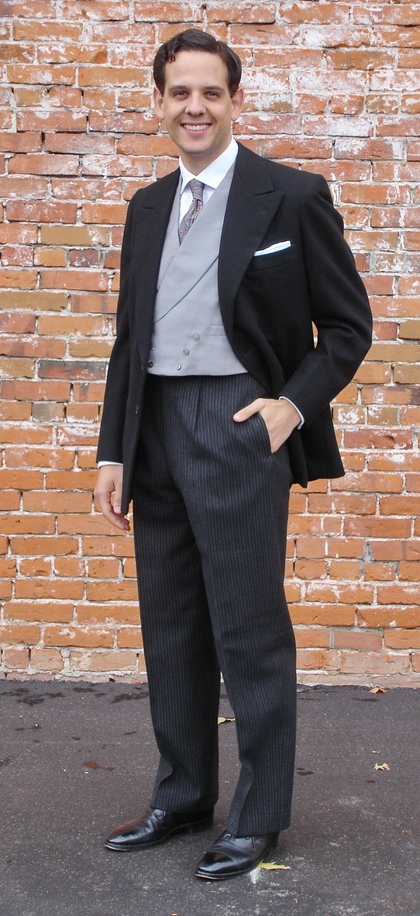

(The first picture is a property of The Gentleman's Gazette.)
Stroller is a semi-formal daytime men dress. Nowadays it's rarely seen. It's a daytime equivalent of black tie (usually called tuxedo). A kind of stroller is a stresemann - the only main difference is that stroller can contain both single- and double-breasted jackets, while only the single-breasted jackets are appropriate for stresemann. Despite this difference, in some countries these names are used interchangeably. In Great Britain a name "black lounge" is used for this garment, from "lounge coat", a regular suit jacket in British English. Stroller has got many similarities with morning dress, so there will be many referencess as well.
Stroller is composed of:
- jacket. Exactly this is the only main difference between morning dress and stroller. But not every lounge suit jacket is suitable for this dress. It should:
- be single- or double-breasted (for stresemann only single-breasted), quantity of buttons unrestricted
- be made of wool
- be black or Oxford gray
- have peaked lapels (notched, or these as in regular suit, also are acceptable, but less formal - stroller becomes too similiar to regular lounge suit)
- have besom pockets (i.e. pockets with welts on edges), preferable without flaps, and one welt breast pocket
- have four buttons on each sleeve
- not have any vents.
- striped trousers - see morning dress. Checked and plaid trousers are more appropriate for stroller than for morning dress.
- a waistcoat - see morning dress. The most popular waistcoats for stroller are made of the same material as the jacket. They also appear more frequently in black.
- a shirt. At the beginning of its existence, the shirt of stroller had wing collar (the first type of morning dress shirt). Later, turndown collars were worn, both detachable and attached, as in standard lounge suit shirt. Other details as in morning dress.
- neckwear. It should be a regular four-in-hand necktie, preferable silver. Bow ties in dark colour are also correct.
- footwear - see morning dress.
- socks - see morning dress.
Accesories:
- a hat - a bowler (less formal) or homburg (more formal) in black or midnight blue:


A summer hat corresponding with formality with homburg is a straw boater:

All other accesories as in morning dress, well, maybe excluding spats. :) Today canes also aren't used frequently with semi-formal and informal garments. Wristwatches (these shown with morning dress) are also suitable for stroller.
5. Lounge suit:

A lounge suit (nowadays simply called suit) is the most popular elegant informal men dress. It is frequently worn by politicians, bankers and the most of white-collar workers, as well as bridegrooms (at least here, in Poland).
Lounge suits are both daytime and evening garments. They can be three- and two-piece (the latter don't contain waistcoat or it's in different colour as the jacket and trousers).
Their characteristic feature is that all pieces are in the same colour and (usually) they are made of the same material. Sometimes pieces of suits are mixed and eg. black trousers and gray jacket is worn. It isn't inconsistent with rules, but it divides the dress into two parts, thus people wearing such a garment can seem shorter than in the reality. Often suits are patterned with pin stripes or chalk stripes, checks and plaids are rather rare. The most popular colours are black, various hues of gray, navy blue, brown (according to some more distinguished gentlemen, in pursuance of rule "no brown in town", acceptable only out of town) and beige (too stark white should be avoided) and the most common materials are wool (including tweed; used for year-round suits or only for colder months), linen, cotton and silk (only for light, summer dresses).
A lounge suit consists of:
- a jacket. It can be single- or double-breasted (the latter more formal). It can have notched lapels (these the most popular; in the case of single-breasted jacket) or peaked lapels (in the case of double-breasted jackets). It can have one vent (sporting, American type; impermissible for double-breasted jackets), two vents (English type) or none (Italian type). Single-breasted jackets usually have two or three buttons (a jacket with one button looks like a bit shorter morning coat - quite elegant in my opinion), double-breasted ones six with one or two fastened. Pockets of the former often have flaps, and the latter are more formally besomed, as for stroller. Breast pockets are usually welt, as in formal garments. The best jackets have four buttons on each sleeve.
- trousers. They usually are in the same colour as jacket and are made of the same material. They can have pleats or not, but the first option is more elegant and comfortable. They also can be worn with braces or belt.
- waistcoat. An important piece of a three-piece suit and in some cases two-piece as well. It's usually simple, single-breasted, without lapels, which doesn't mean that double-breasted or lapelled waistcoats are inappropriate. Recently, especially in wedding suits (at least in Poland :) ), waistcoats in contrasting colours are seen. Despite that the dress is composed of three parts then, it's still a two-piece suit, because in three-piece suit all pieces must match. Such contrasting waistcoats are acceptable, but it must be remembered that neckties matching waistcoats are considered inappropriate and "waiter-esque". The only exceptions from this rule are colours black, white and in some cases gray.
- a shirt. It is a quite easy part of a lounge suit, but it must follow two rules:
- it should have long sleeves
- its colour should be brighter than the colour of the suit and the necktie (patterns are permissible).
The most popular are attached turndown collars, altough detachable ones are also seen. The other types are too formal for a contemporary lounge suit. There are also turndown collars, buttoned down to the shirt with two buttons. However, they are more appropriate for less formal garments. The shirts can have both single and double cuffs, the more elegant are closed with cufflinks, the less - buttons. The front is usually fastened with buttons, sometimes have fly front.
- neckwear. Today it's usually a regular, four-in-hand necktie. Bow ties are appropriate, but thay can be considered as eccentric by some. Ascot ties, as for first type of morning dress shirts, but often in other colours, are also more extravagant. In my opinion, they are suitable only when the suit contains a waistcoat.
The necktie should always be darker than the shirt. As an alternative, in 60's scarves tied in a special knot (like the regular four-in-hand knot, but without the last step - the one end isn't put through the loop) were worn with suit. In late 90's and at the beginning of the XXI century, wearing a necktie matching the shirt or even a light necktie with dark shirt was popular. A black suit with a black shirt and white necktie is stereotypically associated with gangsters and mafia. :)
- footwear. Various models and colours of shoes are worn with lounge suits. The most popular and correct are however oxfords (with closed lacing; as for morning dress) and derbies (with open lacing; informal). The most frequently seen colours are black and brown (preferred for bright suits).
- socks. It is said that they should be of matching or similiar colour to the colour of trousers. Really, they can be any colour, I'm quoting (as a matter of fact I don't know whom): "A businessman matches his socks to his pants. A gentleman matches his socks to his mood". :) The best is however to choose brighter socks for brighter suits and darkers socks for darker suits.
Accesories:
here is more leeway. The coat can be any, like gloves, boutonniere and hat (it only shouldn't be a top hat). Also either belt or braces, pocket or wristwatch (it however shouldn't be sporting), with or without cane can be chosen. :)
That's all about this very complicated garment, which has got so many cuts and models, that no one can be chosen from them. ;)
6. Navy blazer:

It's the least formal elegant men dress, both daytime and evening. It's characteristic elements are golden or silver buttons. A waistcoat isn't worn with it. Of course blazer can be worn with T-shirt, but then the garment losts its elegant nature. ;)
The set of navy blazer is composed of:
- a navy blazer itself. It doesn't differ in cut much from regular lounge coat. It should:
- be double-breasted, though recently also single-breasted models come up
- if it's double-breasted, it must have six or four metal (usually golden or silver) buttons (one or two fastened, very rarely models with two buttons with one fastened appear), if it's single-breasted it usually have three or two buttons
- have four metal buttons on each sleeve
- be navy blue (under the name), though today also black and charcoal are seen
- have two vents
- have patch or flap pockets and welt breast pocket (the welt isn't neccessary, but rather the most popular).
- trousers. They should be gray, as for a lounge suit. The lighter hue of gray, the less formal ensemble. They can be worn with braces or a belt. Theoretically (as for T-shirt) also beige or khaki trousers are acceptable, but it's highly casual.
- a shirt. The same model as for lounge suit, the best colours are light pink, blue and white.
- neckwear. It can be four-in-hand, bow tie or ascot tie, plain or patterned. In spite of all, I don't recommend the ascot tie this time. ;)
- footwear. For a navy blazer, the most correct are black or brown derbies. Oxfords are too formal in this case.
- socks - see lounge suit.
Accesories - see lounge suit. It must be remembered that a cane is a rather obsolete accesory and if we want to carry it with all garments, not only formal, we must be prepared for this can look old-fashioned and affected, but if it looks good, why not? ;)
That's all about a navy blazer and about daytime dresses at the same time. Now we move on evening dresses, which are fewer, and rules about them are more strictly determined.
1. White tie:
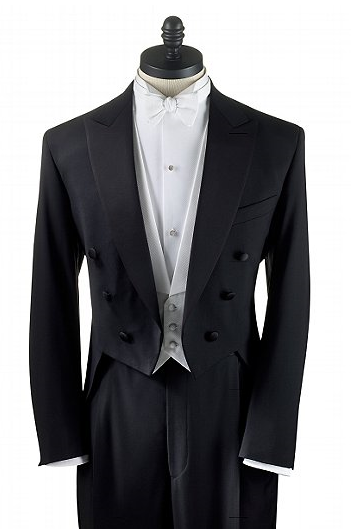

White tie, also known as tails, is the most elegant formal evening men dress, and in my opinion also the most elegant men garment. At the end of XIX century it was replaced by the black tie (also known as tuxedo). Because this dress comes from an uniform, in fact there are few things which can be changed in tails.
White tie is also a traditional and the most appropriate for an opera.
A traditional white tie consists of:
- dress tailcoat. It's a frock coat with a part of cloth cut away, but it is in the other shape as in morning dress, like it can be seen on the pictures. The dress tailcoat should:
- be made of wool,
- be black or midnight blue (this second option is a lot more original, but it must be remembered, that a white tie don't have to be original, but rather in the most the same as others):
- have peaked lapels, lined with satin or grosgrain (the second one is considered more distinguished; in midnight blue tailcoats the silk is often black instead of blue, but the choice of colour is dependent on the preference of the owner)
- have one vent
- be double-breasted, but never fastened
- have six buttons in the front, two at the back, over the vent, and four, touching with edges, on the sleeves - all lined with the same kind of silk as on the lapels
- have one welt breast pocket (some obsolete models haven't got it).
Traditionally, shawl lapels are also correct, but nowadays chances on seeing it are equal with chances of seeing a man strolling around in the old town of Warsaw in frock coat ( :) ):
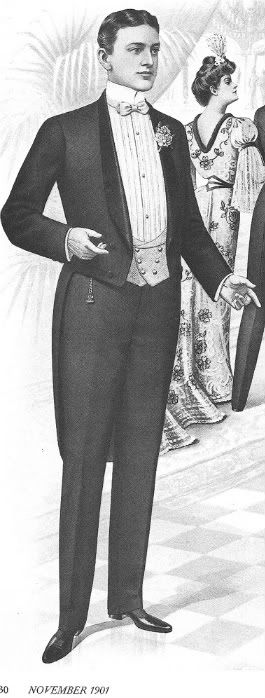
- trousers. They should:
- be in the same colour as the tailcoat
- have one wide or two narrow stripes on side seams made of the same kind of silk as on the lapels of the tailcoat
- be made to be worn with braces
- have two pleats on each leg
- not have cuffs.
Correct, but equally obsolete and rare are breeches, or trousers reaching slightly below the knees, worn with black or white stockings and pumps:

- a waistcoat. Once, two variants were worn - black and white, now the only correct colour is white. Besides that, it should:
- be backless, or be fastened at the back with two straps, it looks like that (this one is actually black, for black tie, but the shape is still the same):
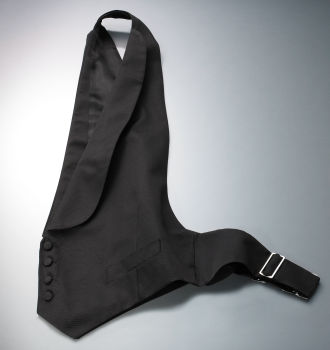
- have eyelets in the front instead of buttons, where waistcoat studs are inserted (in the case of tails, golden with mother of pearl are the most appropriate)
- be single- or double-breasted, in the first case it should have three studs, in the latter - four
- be made of white pique
- have oblong lapels with rounded or pointed bottom
- have two welt pockets
- not extend from the bottom of the tailcoat, as it can be seen on the illustrations.
It also must be remembered that in contrast to daywear waistcoats (for morning dress, lounge suit), evening waistcoats should be always fastened with all buttons or studs.
- a shirt. It should:
- be white
- have linen, cotton or pique stiff bosom
- have stiff, high, detachable wing collar with bold (broad) wings, slightly bigger than for morning dress (first type of shirt)
- have single cuffs closed with cufflinks (golden with mother of pearl)
- be fastened with one or two studs (golden with mother of pearl), number dependent of the wearer's height.
An alternative to wing collar is a regular, standing imperial collar, detachable of course. An example of this juxtaposition can be seen on the photo of the tailcoat with shawl collar.
- neckwear. It should be a white bow tie, self-tied, made of pique (matching waistcoat) or silk. We can choose between three shapes:
- "butterfly":

- modern "butterfly" or "thistle" or "semi-butterfly":
- "batwing":
Bow ties can also have pointed ends:
- footwear. It must be black patent leather, but we have to choose between two kinds of shoes:
- patent leather oxfords (the same shape as for morning dress), they shouldn't have any embellishments:
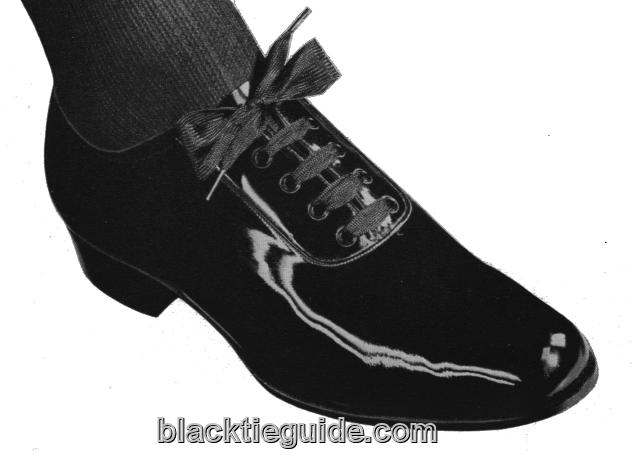
- patent leather pumps, with grosgrain bow (they are considered too feminine by some, but they look very elegant :) ):

Some prefer calf leather instead of patent leather, but I think that they don't have an appropriate look for evening wear.
- socks. They should be black, made of silk.
Accessories:
- a cane - (note - the piece of information was changed 10.02.11) in spite of the common belief (which even I had believed) the cane shouldn't be black with white ball handle. Emily Post, in her celebrated etiquette book (1937-1965 edition) says that such a cane is "the hallmark of the 'imitation gentleman' and never carried by a real one." A proper white-tie cane is black, with any handle, not gold or silver plated nor made of mother if pearl or ivory. It just should be all black.
- gloves - white, buckskin for outdoors, kid for indoors.
- a scarf - white, silk, with tassels:

- a hat - the best is a black collapsible top hat (opera hat):


A habit of wearing collapsible hats for tails appeared because there weren't any cloakrooms in opera houses, so everyone tried to make hats easy in storage.
After all a regular, non-collapsible top hat, as for morning dress, is also correct.
- an overcoat - appropriate overcoats for white tie are Chesterfield or Inverness in black or midnight blue. Inverness is a special overcoat with attached cape, it looks like that:

A correct outerwear is also an opera cloak, the most appropriate in summer, because there is a rule (today commonly forgotten), that some outerwear must be always worn with white tie, in spite of weather. I don't know whether these are still sewn, anyway I couldn't find any photos of cloaks correct for white tie. I can depict it: it's usually black, it has a high collar and it's closed in the front by a chain or frog link. It's generally made of wool, velvet or silk.
- a handkerchief - white, linen.
- a boutonniere - white or red.
- a watch - only appropriate choice is a pocket watch on a watch chain.
- braces - white, silk, button-on.
That's all about tails, my favourite garment. :)
2. Mess jacket:
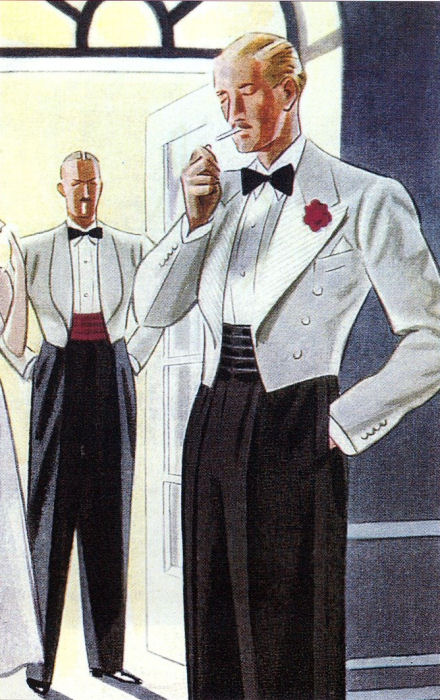


Mess jacket is actually a relict of formal wear popular in 30's. Today it's only used as a mess dress for soldiers, ship capitains, etc. On the first and second illustrations there are civil versions, on the third there is a military version. A mess jacket went out of fashion because it looked good only on thin men, and also because that garment soon became an uniform for bell hops and jazz musicians. Here I will talk only about a civil version, which is one of the correct alternatives for dinner jacket in tropics and also in summer in North America.
I warn that the most of informations written here is based on quite cheeseparing informations from Wikipedia, moreover some of them come from the page of the military version. However I think that they apply for the civil version, too. ;)
The set of mess jacket contains:
- a mess jacket. It should:
- be made of white or off-white linen or cotton
- be built similiar to a dress tailcoat, but without tails (it should extend a little below the waist)
- have shawl (the first illustration, in the background) or peaked lapels (the first illustration, in foreground, the second illustrations, the third illustration) lined with satin or grosgrain (mainly for peaked lapels)
- be double-breasted (six or four buttons lined with the same kind of silk as on lapels) but never buttoned (as in tails)
- have four buttons on each sleeve (lined with the same kind of silk as on lapels)
- have one welt breast pocket (it isn't neccesary, as in tails).
Golden buttons and link closure (see morning dress) are features seen mainly in military version, but also appropriate for civil version. If the jacket is white, the silk covered buttons can be replaced with mother of pearl ones.
- trousers. They are usually made of the lighter material, they are black or midnight blue and they are always worn with braces.
- a waistcoat or a cummerbund. White pique waistcoat (as for white tie) and cummerbund in black, red or navy blue are correct. There should be one stripe of the same kind of silk as on lapels on side seam on each leg.
- a shirt - see white tie. Version with turndown collar and pleated or plain bosom was also worn, it is however less formal, although the most popular and the only one seen on period illustrations.
- neckwear. It should be a black bow tie made of the same silk as on lapels, usually in "butterfly" or "thistle" shape.
- footwear - see white tie.
- socks - see white tie.
Accesories:
- a cane - optional, as suits one fancy.
- gloves - mess jacket is a garment worn only in summer, so only gloves that can be worn with it are white kid or silk, as for indoors for white tie.
- a hat - the most correct is a straw boater, straw, so warm-weather, like the garment.
- an overcoat - it rather isn't worn for warm-weather dresses. :)
- a handkerchief - in contrast to other formal dresses, a handkerchief can be white linen or coloured, usually silk. Dark colours like maroon or bottle green should be used however.
- a boutonniere - preferable red. If we wear a coloured handkerchief, the best is to ommit a boutonniere, unless it is white.
- a watch - both pocket watch (if the waistcoat is not worn, it should be placed in left trousers pocket, in order to the watch chain stick out a bit, or simply in breast pocket, in this case the best is to insert a T-bar of single-ended watch chain into a buttonhole) and wrist watch (some elegant, preferable as for morning dress) are appropriate.
- braces - any material and colour (preferably the same as for tails), they should be button-on.
Phew, I somehow succeeded. :)
3. Black tie:

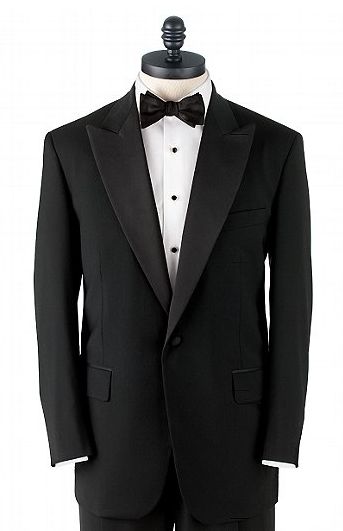
I left the worst at the end. :) A black tie, commonly called a tuxedo (USA) or a dinner jacket (UK) is a semi-formal men evening dress. Its rules are strictly determined which in this case doesn't mean that there's not a plenty to choose from - so if I want to this article be complete, I'll have to describe it all. A dinner jacket also appears in warm-weather version, used in tropics and in North America in summer. It differs from a regular tuxedo with two essential pieces, which will be discussed.
A black tie is composed of:
- a dinner jacket. It resulted from the merger of tails and informal, XIX century smoking jackets, made of velvet, worn on house affairs:

A modern dinner jacket should:
- be made of black or midnight blue wool, warm weather-version - from light wool, cotton or linen in off-white (pure white, though frequently used, is incorrect due to its starkness):
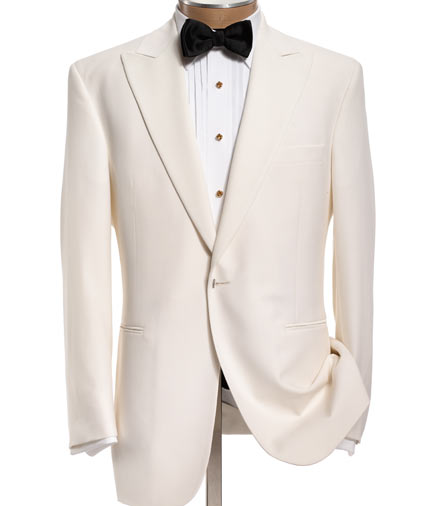
A burma-coloured jacket, popular in 30's, can be used as an alternative:
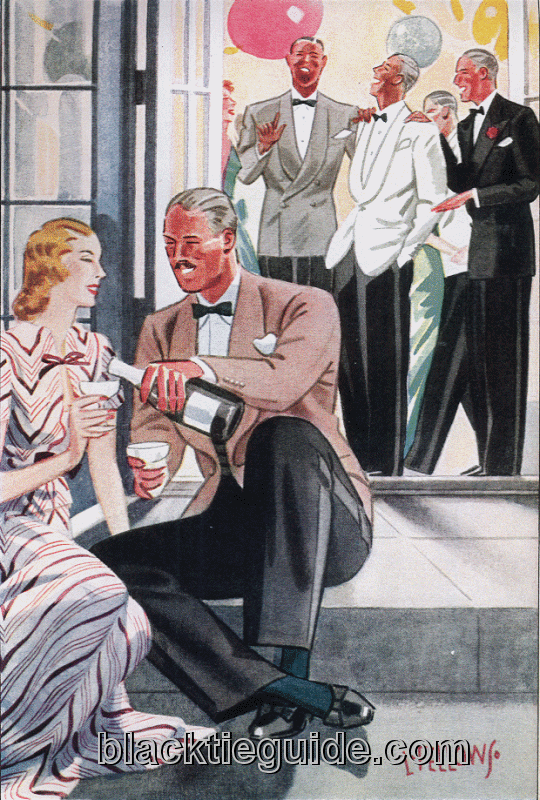
- be single- or double-breasted (the latter option less formal)
- have peaked or shawl lapels faced in satin or grosgrain (more popular to the first shape, and also more formal), warm-weather version - usually shawl lapels, though peaked are also correct, self-faced (i.e. without silk)
- have one button (single-breasted jackets) or four buttons with one or two buttoned (double-breasted version), lined with the same kind of silk as on lapels, in warm-weather version buttons lined with satin if lapels are shawl, grosgrain when they're peaked
- have no vents; minimal side vents are acceptable
- have two besom pockets, without flaps and welt breast pocket.
Among tailors and people familiar to formalwear dinner jacket with one vent, flap pockets and notched lapels is a synonim of a poorly made garment, though such models are quite popular. Prom outfits in USA also enjoy such a reputation, where reign tuxedos in weird colours and atypical accessories, which also characterize "formal" garments from 60's and 70's. If we want our dress to be original, we can wear a velvet black dinner jacket, which refers to Victorian smoking jackets and doesn't lose anything (worn with regular black tie trousers):

- trousers. They should:
- be made of the same material in the same colour as the jacket, warm-weather - black or midnight blue trousers, they can be made of lighter wool than for regular dinner jacket
- have one thin stripe on each leg, made of the same kind of silk as on lapels
- narrow downwards
- be made to be worn with braces
- have two pleats on each leg
- not have cuffs.
- a waistcoat or a cummerbund. Tuxedo waistcoat probably doesn't differ in anything from a full-dress waistcoat. There are some differences, though:
- silver and onyx studs are worn with them
- it should be made of silk (matching lapels) or the same material as jacket
- though black (or, certainly, midnight blue) is traditional, nowadays also dark colours, like maroon, navy or bottle green etc. are correct. Maybe it's a good way of introducing colour to black tie, but for me it's overly colourful. It we decide to do it although, the best is to not use any other coloured accesories (which accesories, I will tell in a moment). And, of course, never a matching bow tie.
If we want to give to a dinner jacket more festive, formal character, or simply if a white tie is preferred to some celebration and we don't own it, then a white pique waistcoat (as for tails) is also correct - a habit of wearing it originated during 30's:

Now about a cummerbund - it comes from India. A habit of wearing it for evening dress was originated by British officers serving in India in 1889. Originally it was a long, silk sash wrapped around the waist four times. Later it gradually disappeared, until 1920, in such shape as it has now:

The cummerbund is silk (matching lapels), usually pleated, it is worn with pleats facing up. It is a memento that once formal trousers didn't have pockets, so gentlemen wearing them stored their tickets and money in their cummerbunds. The oft repeated claim that the pleat direction allows a cummerbund to catch crumbs is as ludicrous as stating that a French cuff's extra fabric is intended for wiping one's mouth (I quote Peter Marshall from Black Tie Guide). :) Like the waistcoat, the cummerbund can also appear in colours other than black. It is also preferred for warm-weather version. Like in the case of the waistcoat, bow ties matching colour of the cummerbund are inappropriate.
Recently a habit of wearing dinner jacket without any waist covering originated, but it isn't traditional, moreover when the jacket is buttoned, a part of white shirt may be seen. It also shows a trousers waist line, which should be covered. It can be ommited however, using special trousers with a silk stripe sewn on:

In spite of all I don't recommend wearing a dinner jacket without neither waistcoat nor cummerbund, because it's simply incorrect for such garment. If Daniel Craig as James Bond did it, it doesn't mean it's appropriate. It is better to epitomize the old, good Sean Connery. :)
There's one more important information - the only case when neither waistcoat nor cummerbund is worn is when the dinner jacket is double-breasted. It is certainly correct.
- a shirt. Here's quite a lot to choose. There are four things that differ black tie shirts - a collar, cuffs, fastening method and bosom. First versatile details for the most types - the only collars appropriate for dinner jacket are wing (considered incorrect in Great Britain, due to visible bow tie band):
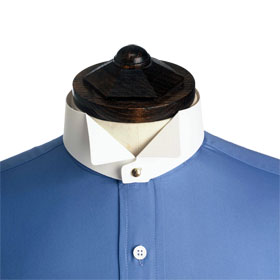
and turndown:
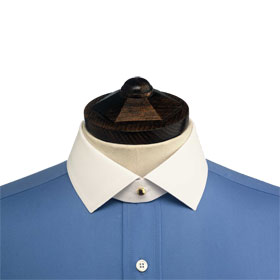
Cuffs in most of cases are double.
The bosom is always made of extra layer of material sewn on the shirt. It can however have different finish, depending on formality.
There are two correct methods of fastening a dinner jacket shirt - by studs (preferable silver with onyx, one, two or maximally three, depending on the wearer's height) or with fly front. The cuffs always fastened by cufflinks:
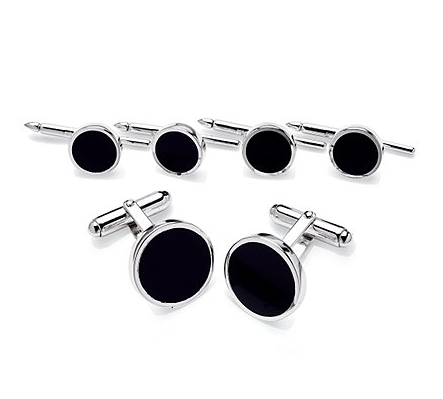
So let's start the enumeration, beggining with the most formal:
1. Detachable wing collar, single cuffs, stiff bosom, fastened by studs - or that as for white tie. Here, as exception, white tie studs, or golden with mother of pearl are preferred.
2. Detachable wing collar, single cuffs, pleated or plain bosom, fastened by studs or with fly front - undoubtely the least common used combination.
3. Attached wing collar, double cuffs, pleated or plain bosom, fastened by studs or with fly front - a usual variant of dinner jacket shirt in USA.
4. Turndown collar, double cuffs, pleated or plain bosom, fastened by studs or with fly front - today standard in Europe, preferred for warm-weather version of dinner jacket.
That's all about shirts - I must admit that there's so much possible combinations, that I recommend the section about shirts on Black Tie Guide (the link at the beggining of the article). Oh, there's one more thing - the shirt should always be white.
- neckwear. It is a bow tie, in one of shapes I've mentioned in white tie. The most important here is the colour; to know which is correct and which not, you have to have a quite large knowledge. I possessed it by reading Black Tie Guide, so I reccomend this site to everyone. So let's start - formal men wear advisers are split into two groups - the first think that the bow tie can be any colour except white (with matching cummerbund obviously ;/). The second are more traditional, and thus closer to the thruth - they state that the only appropriate is a black bow tie. In the meanwhile, there are three colours of bow ties correct for a regular dinner jacket and four appropriate for warm-weather version:
Traditional colours include:
- black:

- midnight blue (the darker hue, the better):

- black with white, subtle pattern:

For warm-weather dinner jackets, besides mentioned above, maroon is also used (frequently with matching cummerbund):

The safest is however to wear simple black bow tie - it is elegant and traditional. A material, which the bow tie is made of, is dependent on the jacket lapels facing. If it's satin, then the bow tie should also be made of satin. If the lapels are lined with grosgrain, the bow tie should be made of textured material, not necessarily grosgrain, eg. faille ot barathea. That's how bow tie textures look alike:
- satin:

- faille:
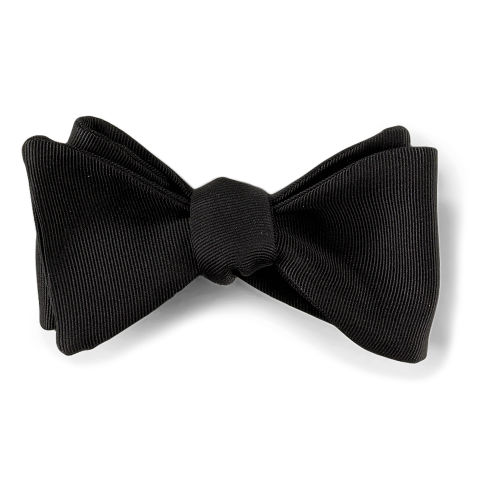
- barathea:
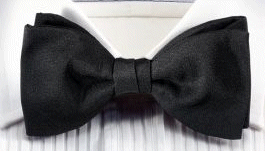
- footwear - see white tie.
- socks - see white tie.
Accessories:
- a cane - it is considered too affected for black tie. If it however doesn't prevent the wearer, there's rather no problem. :)
- gloves - they should be gray suede or leather. Indoor gloves (as for white tie) are quite obsolete, and worn with dinner jacket they look very theatrical. I however think that they are appropriate for minor events, everything also is dependent on the taste. According to Wikipedia, they shouldn't be made of kid leather, but rather silk.
- a scarf - white silk, with tassels, as for white tie.
- a hat - homburg in black or midnight blue. A straw boater is also appropriate for warm-weather wersion.
- an overcoat - the most correct is a dark Chesterfield, although other long, dark overcoats (these I mentioned in white tie among others) are also appropriate.
- a handkerchief - it should be white linen, though coloured silk are also correct, even preferred for warm-weather version.
- a boutonniere - there are four kinds of flowers commonly considered appropriate - blue cornflower, white gardenia and white or red carnation:



Usually a boutonniere and a handkerchief aren't worn the same time, unless at least one of them is white.
- a watch - a pocket watch is the most formal, wristwatch must be silver, with black band:

- braces - they should be silk, button-on. The traditional colour is black, white, or combination of both. Nonetheless, the colour of braces isn't important, because they are an element of underwear and should never be seen. White is preferred for warm-weather version on black tie, because dark colours could be seen throughout bright, thin material of the jacket.
It seems that that's all. :) I hope that I satisfied your curiosity about elegant dresses for a long time.
Best regards, Dr Kilroy
P.S. The photos are mainly from sites Black Tie Guide and the site of tailor shop Knize. The first photo of tails - Brooks Brothers, the photo of a pocket watch with a lid - Gentleman's Emporium.

As a character designer for animation films. i can say that this is an extremely usefull (and visual clear) post on formal and less formal wear. Just what I need as a quick reference of the gentleman's dressing code.
ReplyDeleteThank you for sharing your knowledge.
Thank you!
ReplyDeleteI work for the theatre designing costumes. This was a saver. Excellent attention on details. Makes all the difference.
ReplyDeleteI'm glad I helped. Well, details is what the formal attire is composed of. ;)
ReplyDeletesame deal here, I help with character and costume design for video games... this has been super informative. Thanks for your devotion to this subject.
ReplyDeleteDue to a lack of tailoring apprenticeships in Australia (where I live) I am teaching myself how to make suits. Your blog has been so informative and helpful!!! Can we look forward to more posts on elegant dressing? I hope so!
ReplyDeleteVery nice and helpful article.
ReplyDeleteBut... some pictures are not loading =(
I have noticed that. I will fix it as soon as possible.
ReplyDeleteBest regards, Dr
To the good Dr,
ReplyDeleteHere's hoping you will be able to fix the issues regarding many of the pictures not loading?
Keep up the wonderful work.
i agree, most of the pictures can't been seen, which sucks as the ones that do appear are really good.
ReplyDeleteany chance of seeeing them?
All right, I am going to fix it now.
ReplyDeleteBest regards, Dr
Something else about mess jackets: They had to have special trousers with no back pockets (no slits to see!) Military formals, such as the concert uniform of the U.S. Navy Band, still follow this rule.
ReplyDeleteReading P. G. Wodehouse, I came across a reference to the Mess jacket. Not knowing this garment, I googled - and ended up here. What an excellent and well-researched article!
ReplyDeleteHowever, having seen the illustrations of the mass jacket, I can now understand why Jeeves was so disapproving of Bertie Wooster's purchase... :-)
There are two new settings that are becoming more and more popular in the informal spectrum: grey suit for morning and black suit for evening. They seem too common in weddings and other events nowadays.
ReplyDelete